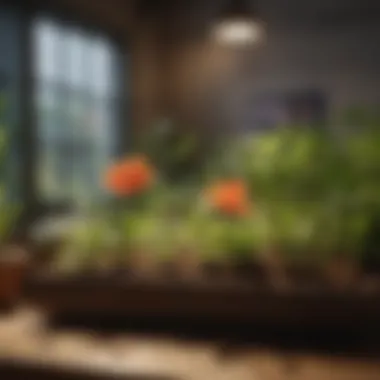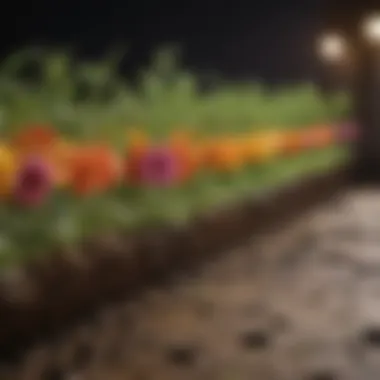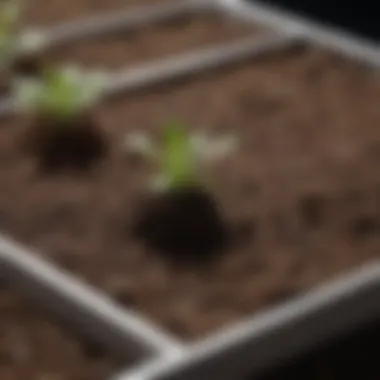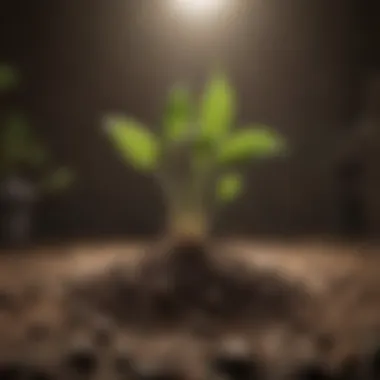Optimal Timing for Starting Flower Seeds Indoors


Intro
Understanding when to start flower seeds indoors is crucial for any gardening enthusiast. This decision can significantly affect the health and vitality of the plants over the growing season. Planting seeds at the right time allows the gardener to take advantage of the lengthening days and warmer conditions that encourage robust growth. Various factors come into play, including regional climate, specific flower varieties, and individual growth patterns. These variables can alter what might seem like a straightforward decision into a complex strategy for optimizing indoor gardening success.
The following sections will explore key insights into the best practices for starting flower seeds indoors. Additionally, practical tips will be offered to guide both novice and seasoned gardeners in their endeavors.
Key Insights and Trends
Importance of Timing
Timing is not just about seasonal changes; it is also about understanding local weather conditions and microclimates. Many gardeners find that starting seeds too early can lead to overly leggy seedlings, while starting too late can result in stunted growth or missing the peak growing season.
Current Trends in Indoor Planting
Among indoor gardening communities, there is a noticeable shift toward using heirloom and native flower varieties. These choices not only support local ecosystems but often prove to be more resilient to environmental stressors.
Popular Gardening Techniques
Many enthusiasts are currently exploring in-depth planting methods, such as:
- Soil Blocking: This technique helps to minimize transplant shock and promotes healthier root development.
- Hydroponics: Some gardeners are experimenting with water-based systems to grow seedlings, creating a faster growth cycle.
- Companion Planting: Understanding which plants grow well together can maximize space and yield, especially in limited indoor environments.
Practical Tips and How-To Guides
Setting Up for Seed Starting
- Choose the Right Containers: Opt for seed trays, peat pots, or biodegradable pots that provide adequate drainage.
- Quality Seed Starting Mix: Utilize a light, fluffy mix designed specifically for seed starting to ensure proper drainage and aeration.
- Provide Adequate Lighting: Position trays under grow lights or in a south-facing window to ensure they receive sufficient light without being too hot.
Monitoring Germination
- Keep the soil evenly moist but not soggy.
- Use a humidity dome to retain moisture until seedlings emerge.
"Seed germination is the stage where life begins anew; getting it right ensures a fruitful season ahead."
After Germination
Once seedlings appear, consider the following steps:
- Thin Seedlings: Once they develop true leaves, thin them to prevent overcrowding.
- Transplanting: Be ready to transplant seedlings once they have formed robust roots and sturdy stems.
- Hardening Off: Before moving seedlings outdoors, gradually expose them to outdoor conditions over several days to acclimate them.
By understanding the best timing and practical techniques for starting flower seeds indoors, gardeners can enhance their success rates. This knowledge not only leads to healthier plants but also enriches the experience of gardening itself.
Understanding Seed Germination
Understanding seed germination is crucial for anyone interested in starting flower seeds indoors. This process serves as the foundation for a successful gardening experience. When seeds germinate, they transition from a dormant state to an active growth phase. Awareness of the germination process aids in selecting the right seeds and ensuring optimal conditions for their growth.
Gardening enthusiasts can benefit from this knowledge by maximizing seed potential and minimizing challenges during the initial stages of plant development. Additionally, recognizing the various factors that contribute to effective germination helps in planning the indoor gardening process more efficiently.
Biology of Seed Germination
Seed germination is fundamentally a biological process that involves several stages. Initially, seeds absorb water through a mechanism called imbibition. This water uptake is crucial as it activates metabolic processes within the seed. As the seed swells, it breaks through its protective seed coat, allowing the embryonic plant to push out its first leaves and roots. This entire process can be influenced by a range of external factors, making understanding the biology of seed germination essential for effective indoor seed starting.
Factors Influencing Germination
Several factors influence the germination of seeds, and understanding these can lead to more successful outcomes. Key influences include moisture levels, temperature range, and light requirements. Each of these factors plays a vital role in seed health and growth.
Moisture Levels
Moisture levels are critical for seed germination. Seeds need a certain amount of water to activate internal processes. High moisture can be beneficial because it ensures that seeds swell properly and begin germination. However, too much moisture can lead to rot or mold, negatively affecting the seeds. Therefore, maintaining the right balance is essential for the success of the gardening endeavor.


Temperature Range
The temperature range impacts germination significantly. Each flower variety has its own preferred temperature range for optimal growth. Generally, warmer temperatures expedite germination and lead to faster growth. However, excessively high temperatures can stress the seeds, hampering development. Understanding this, gardeners can choose the right timing and environment for starting their seeds indoors.
Light Requirements
Light requirements vary among seed types and can affect germination success. Some seeds prefer darkness for initial germination, while others benefit from light exposure. Proper light conditions not only aid in the germination phase but also set the stage for healthy seedling growth. Awareness of the specific light needs of different flower varieties is essential for successful indoor cultivation.
"Germination is the first step towards a flourishing garden; understanding its intricacies leads to better outcomes."
In sum, seed germination is a fundamental process for indoor gardeners. Recognizing the biological aspects and external factors influencing germination allows for a more tailored approach. This approach ultimately increases the likelihood of successful growth, enriching the overall gardening experience.
Climate Considerations
Understanding the climate where you live is vital for successful indoor seed starting. Different climates affect seed germination, growth rates, and transplant success. Knowledge of climate considerations allows gardeners to make informed decisions about timing and the specific conditions needed for various flower seeds. This section dives into two important aspects: hardiness zones and the influence of local weather patterns.
Hardiness Zones Explained
The concept of hardiness zones offers a standard way to categorize different climate types based on a specific area’s average temperature during winter months. The USDA Plant Hardiness Zone Map, for example, divides regions into 13 zones, each representing a 10-degree Fahrenheit range of average annual minimum temperatures. Knowing your zone helps you choose flowers that thrive in your area's conditions.
- Zone 1: Extremely cold. Minimum temperatures can drop below -60°F.
- Zone 5: Moderate cold. Minimum temperatures range from -20°F to -10°F.
- Zone 10: Warm and temperate, with minimum temperatures above 30°F.
When planning to start seeds indoors, identifying your hardiness zone helps in selecting specific flowers that can be planted. For instance, selecting varieties that are suited for a Zone 6 region will enhance the probability of successful growth as you initiate your seedlings indoors.
Impact of Local Weather Patterns
Local weather patterns significantly impact indoor seed starting and ultimately, the growing season. Each year may bring different weather conditions, including temperature fluctuations, precipitation levels, and frost dates. These factors can alter the best times for sowing seeds indoors.
Key elements to consider include:
- Frost Dates: Knowing the average last frost date in spring is essential for planning.
- Precipitation Patterns: Understanding rainfall trends helps in managing watering schedules for seedlings.
- Temperature Variability: Sudden changes in temperature can harm young seedlings.
By keeping an eye on local forecasts and historical weather data, gardeners can better adapt their planting schedules, ensuring that seedlings are ready to be transplanted outdoors at optimal times.
Understanding your local climate and hardiness zone is crucial for successful indoor seed starting.
Identifying the Right Timing
Timing is an esssential aspect when it comes to starting flower seeds indoors. Optimal timing ensures the highest yeild and the healthiest plants. It involves considering factors such as the climate of your region, the particular flower variety, and local weather conditions. By nailing down the right timing, gardeners can achieve better consistency in germination and growth.
The shifting of seasons impacts how plants grow. Starting seeds too early can lead to weak sprouts that will stretch toward the light and become leggy. Conversely, starting seeds too late may result in less mature plants by the time transplanting occurs. Therefore, calibrating your start dates to your local conditions leads to successful gardening with a more abundant flowe output.
General Guidelines for Indoor Seeding
When starting flower seeds indoors, there are some general guidelines to follow. First, always check the seed packet for specific information regarding the best planting period. This helps in understanding the unique needs of the variety you are planting.
Second, use a calendar and note down your last frost date. This provides a framework for planning when to begin the indoor seeding process. Generally, seeding should occur about six to eight weeks before the last frost date in your area.
Third, consider the overall health of your seedlings. They require ample light to grow strong, and if natural sunlight is not sufficient, employ grow lights for an extra boost.
Specific Timing for Different Flower Varieties
Annual Flowers
Annual flowers are a popular choice for many home gardens due to their vibrant and flamboyant blooms. They complete their life cycle within a single growing season, making them great choices for quickly filling garden spaces.
Common species like Petunias and Marigolds thrive with proper timing. Typically, these flowers should be seeded indoors around 6 to 8 weeks prior to the expected last frost. This time frame allows them to establish before being transplanted outside.
However, one should be cautious. Starting them too early might lead to crowded containers and more factors like root bound plants.


Perennial Flowers
Perennial flowers, unlike annuals, return year after year. Specific varieties, such as Echinacea or Daylilies, benefit greatly from careful timing. They generally need 8 to 10 weeks of indoor growth before being moved outdoors. This longer preparation time allows them to develop a stronger root system.
It’s essential to wait for the right window for perennial seeds, as improperly timed planting can damage sensitive seedlings or delay flowering times.
Heirloom Varieties
Heirloom varieties have gained popularity among gardening enthusiasts for their unique characteristics and historical value. Flowers like Nasturtiums and Cosmos fall into this category. Starting heirloom seeds indoors typically requires about 6 to 8 weeks before the last frost.
They offer benefits such as resilience against various diseases and the ability to stimulate biodiversity. However, maintaining true heirloom genetics demands careful attention to timing. Inconsistent planting practices could compromise those sought-after traits, while leading to reduced overall yield.
In summary, understanding the optimal timing for indoor seed starting is crucial for achieving successful flower growth, allowing for beautiful displays and bountiful harvests. Engaging with these elements ensures you maximize your indoor gardening efforts.
Advantages of Starting Seeds Indoors
Starting flower seeds indoors presents numerous advantages that can significantly improve the gardening experience and success rate of flower cultivation. This method allows gardeners not only to save time but also to gain a variety of control over various environmental factors. One major advantage is the ability to extend the growing season. It allows homeowners to get a head start on planting, especially in regions with shorter growing seasons.
When seeds are started indoors, they can germinate and grow in a stable environment. This offers better protection against harsh outdoor conditions, such as unexpected frost or heavy rain. Moreover, seedlings can flourish under controlled conditions where light and moisture are optimized, leading to stronger plants overall.
Through indoor seed starting, gardeners also have the opportunity to select specific seeds based on their preferences and climate. With a well-timed planting schedule, one can ensure that seedlings are ready for outdoor transplanting precisely when conditions are ideal.
These advantages come with an additional layer of responsibility. Indoor gardening requires attention to detail. Not all flower varieties are suited for indoor seed starting. Understanding the specific cases for each type is crucial.
"Starting seeds indoors not only accommodates the needs of different flower varieties but also cultivates a deeper appreciation for the growth process."
Extended Growing Season
The extended growing season is a primary benefit to consider when starting seeds indoors. By sowing seeds earlier in the year, gardeners can push the boundaries of what can be cultivated in their growing zones. The ability to start seeds indoors allows for a significant head start, often translating to earlier blooms and a longer period to enjoy the flowers.
Gradually, seedlings grown indoors are transplantable once the weather is suitable. This simplifies the timing of planting, maximizing available time for blooms. For example, if marigold seeds are planted indoors six to eight weeks before the last frost, gardeners can see these vibrant flowers as soon as the weather permits.
Here are some additional points to consider:
- Optimal Timing: Start seeds according to regional climate patterns to ensure timely transplanting.
- Variety Selection: Choose annuals and perennials that benefit from earlier starts.
Enhanced Control Over Growing Conditions
Indoor seed starting allows for enhanced control over the environmental conditions that seedlings are exposed to. This is especially important for optimum germination and growth. Various factors can be monitored and adjusted according to the needs of the seeds.
Light is one such critical factor that can be easily controlled. Using grow lights, gardeners can simulate ideal lighting conditions, crucial for photosynthesis and strong development. Temperature can be regulated to ensure warmth, which is vital for seed germination.
Moreover, moisture levels can be maintained at a constant, reducing the risk of over or under-watering. Such control minimizes stress on the seedlings, allowing them to develop into robust plants.
Understanding these factors will aid gardeners in maximizing their success when starting seeds indoors:
- Monitor Humidity: Use a spray bottle to moisten soil without over-saturating it.
- Use Quality Soil: A high-quality potting mix will support healthy seedlings.
- Consistent Temperature: Keep indoor temperatures steady to avoid shocks to the seedlings.
Practical Tips for Successful Indoor Seed Starting
Establishing a successful indoor seed starting experience requires careful attention to several key factors. This section aims to provide practical tips that enhance the likelihood of healthy seedlings, setting a strong foundation for future growth. Understanding these elements promotes not only proper plant development but also optimal use of resources.
Selecting the Right Containers
Choosing the correct containers for seed starting is crucial. The container must provide adequate drainage to prevent water accumulation, which can lead to root rot. Containers can be made from various materials like plastic, biodegradable options like peat pots, or even recycled materials. Ensure that each container has holes at the bottom for drainage.
Additionally, consider the size of the container. Seedlings require room to develop strong root systems. Most young plants do well in small containers, but larger plants may need more space as they grow. Therefore, you might want to transfer them to larger pots as they develop.
Key Points for Selecting Containers:


- Ensure proper drainage
- Choose appropriate sizes for your seedlings
- Consider materials that can support growth
Optimal Soil and Fertilizer Selection
Soil quality has a significant impact on seed germination and seedling growth. It is essential to use a high-quality seed starting mix that provides excellent drainage and aeration. Many mixes contain peat moss, vermiculite, and perlite, which are lightweight and help retain moisture while promoting root health. Avoid using garden soil, as it can be too dense and may contain pathogens that could harm the seedlings.
In terms of fertilizer, it's best to start with little to no fertilizer in the mix. Young seedlings do not require much nutrition initially, especially if they are planted in nutrient-rich soil. However, once they develop their first true leaves, a diluted liquid fertilizer can provide essential nutrients.
Soil and Fertilizer Considerations:
- Use a quality seed starting mix
- Avoid garden soil for starting seeds
- Introduce liquid fertilizer after seedlings develop true leaves
Watering Techniques and Frequency
Watering seedlings properly is a delicate balance. Too little water can cause seedling stress, while overwatering can suffocate roots. The goal is to keep the soil consistently moist but not saturated. The moisture level can be monitored by touching the surface of the soil; it should feel slightly damp.
Using a spray bottle or a gentle watering can ensures you do not disturb the delicate roots when watering. A good approach is to pour water directly into the saucer beneath the container. This bottom-watering method allows the seedling to absorb the moisture it needs without overwetting the soil surface.
Watering Best Practices:
- Keep soil consistently moist without saturation
- Use a gentle method for watering
- Consider bottom-watering techniques to prevent disturbance
Keeping these practical tips in mind will greatly enhance your success in starting seeds indoors. Adapt your approach based on the specific needs of your chosen flower varieties and local conditions.
Monitoring and Care Post-Planting
Effective monitoring and care after planting seeds is crucial for the successful growth of flower seedlings. Once your seeds germinate, it is important to observe their progress carefully and provide appropriate care in order to foster healthy growth. The right monitoring practices help you catch any problems early, ensuring that your seedlings thrive.
Understanding Seedling Development Stages
Seedlings go through various stages of development. Each stage has its own specific needs and challenges.
- Germination: This is when the seed absorbs water and begins to sprout. Good moisture and temperature are critical at this time.
- Seedling Stage: After germination, the first leaves, known as cotyledons, appear. These leaves nourish the plant as true leaves begin to develop.
- Leaf Development: During this stage, true leaves emerge. They will photosynthesize and support the plant's growth more effectively.
- Establishment: The roots establish themselves in the soil, and the plant grows stronger.
Monitoring these stages is essential. Check the moisture levels consistently. If seedlings are stretching or appear leggy, it may be an indication they are not receiving sufficient light.
Pest Management Strategies
Pest management is another important aspect to consider post-planting. Seedlings can be vulnerable to various pests, which can hinder their development.
- Regular Inspections: Make a habit of inspecting your seedlings weekly. Look for signs of pests like discoloration or visible insects.
- Natural Remedies: Use solutions like neem oil or insecticidal soap. These can be applied to deter pests without harming seedlings.
- Encouraging Beneficial Insects: Ladybugs and lacewings can control pest populations. Attract them by planting flowers nearby.
- Cultural Practices: Maintain proper hygiene in your growing area. Remove debris that may harbor pests.
"Effective pest management can save your blossoms from detrimental effects and ensure a bountiful harvest."
Transplanting Seedlings Outdoors
Transplanting seedlings outdoors marks a pivotal shift in the cultivation process, transitioning plants from their nurturing indoor environment to the broader ecosystem. This step is not merely about moving plants; it involves critical timing and preparation that can significantly influence the success of your blooming endeavor. Understanding the intricacies of transplanting is essential for any gardener aiming for vibrant and healthy blooms.
Preparing for Transplanting
Before seedlings can move outside, proper preparation is crucial. A well-thought-out approach can enhance the seedlings' chances of thriving in their new environment.
- Acclimatization: Gradually introduce seedlings to outdoor conditions. This process, also known as hardening off, involves placing seedlings outdoors for a few hours each day over a week or so, increasing their exposure incrementally. This step helps reduce transplant shock.
- Site Selection: Choose the correct location for transplanting. Most flowering plants need adequate sunlight, whereas some may thrive in partial shade. Soil conditions play a crucial role; well-drained, nutrient-rich soil is ideal for most flower varieties.
- Soil Preparation: Amending the soil is imperative. Add compost or organic matter to fuel robust growth. This enhances drainage while providing essential nutrients. Testing soil pH may also guide further adjustments.
- Watering: Ensure seedlings are watered well before transplantation. Moist soil aids in removing seedlings from their containers without damaging roots. Additionally, consider watering the transplant site beforehand to create a suitable environment for the seeds.
- Timing: Plan the transplant around local climate conditions. Late spring to early summer is typically ideal, as frost-free days allow substantial growth.
Timing for Safe Transplanting
Understanding the right moment for transplanting can make a vast difference in the plants' future growth. Factors to consider include:
- Last Frost Date: It is vital to be aware of your area's last frost date. Transplant seedlings after this date to avoid cold damage. Many flower varieties are particularly sensitive to frost, which can stunt their growth or even kill them.
- Daytime Temperatures: Monitor weather patterns to make sure daytime temperatures are consistently warm, ideally around 60°F to 70°F. Accustomed to warm indoor settings, seedlings require a stable and warm environment outside, which is conducive to their survival.
- Soil Temperature: Gardener must check soil temperature as well. A soil temperature around 50°F and above is generally favourable for flower seedlings. Some flower types, such as marigolds or zinnias, germinate better in warmer soil.
"Transplanting at the right time is not merely a matter of choice; it is a necessary aspect for achieving gardening success."
- Weather Conditions: Keep an eye on the forecast for wind and rain. Avoid transplanting during windy days, as this can stress seedlings. Likewise, plants should not be moved when heavy rains are expected, as saturated soil can uproot fragile seedlings.
By meticulously preparing for transplanting and timing it wisely, gardeners can increase the likelihood of successful growth for their flower varieties. This step serves as the final bridge between indoor nurturing and outdoor flourishing.



